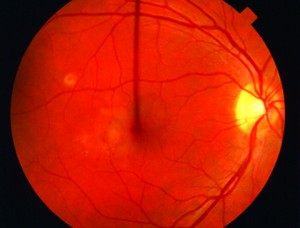By Lauren R. Rosecan, M.D., Ph.D., F.A.C.S.
 Choroidal neovascular membranes (CNVM) are new blood vessels that grow beneath the retina and disrupt vision. These blood vessels grow in an area called the choroid, the area between the retina and the sclera (the white part of your eye). The choroid supplies oxygen and nutrients to the eye. CNVM occur when new blood vessels start to grow in the choroid and break through the barrier between the choroid and the retina. When CNVM leak in the retina, they cause vision loss.
Choroidal neovascular membranes (CNVM) are new blood vessels that grow beneath the retina and disrupt vision. These blood vessels grow in an area called the choroid, the area between the retina and the sclera (the white part of your eye). The choroid supplies oxygen and nutrients to the eye. CNVM occur when new blood vessels start to grow in the choroid and break through the barrier between the choroid and the retina. When CNVM leak in the retina, they cause vision loss.
CNVM are associated with many serious eye diseases, most commonly wet age-related macular degeneration. In addition, CNVM are found in patients with histoplasmosis, eye trauma and myopic macular degeneration, an eye disease in patients who are extremely nearsighted.
Choroidal Neovascular Membranes Symptoms
If you have CNVM, you may experience painless vision loss. You may notice blank spots in your vision, especially your central vision. Your vision may be distorted, so that straight lines appear bent, crooked or irregular.
Who Is at Risk for Choroidal Neovascular Membranes?
Because wet age-related macular degeneration accounts for most patients with CNVM, they are most commonly found inpeople age 50 and older, with the risk growing with age.
However, people with risk factors for different eye diseases or who experience eye trauma may develop CNVM at a younger age.
Choroidal Neovascular Membranes Diagnosis
If your ophthalmologist suspects you may have CNVM, he or she will take special photographs of your eye using fluorescein angiography and optical coherence tomography (OCT).
During fluorescein angiography, a fluorescein dye is injected into a vein in your arm. The dye travels throughout the body, including your eyes. Photographs are taken of your eye as the dye passes through the retinal blood vessels. Abnormal areas will be highlighted by the dye, showing your doctor whether you have choroidal neovascular membranes.
OCT scanning is an imaging technique that creates a cross-section picture of your retina, which helps in detecting abnormal blood vessels.
Choroidal Neovascular Membranes Treatment
Treatment of CNVM may vary depending on the underlying disease. Treatment for CNVM includes anti-VEGF treatment or/and thermal laser treatment .Depending on the progress of your disease, you may receive with one or more of these treatments.
Anti-VEGF treatment
A common way to treat CNVM targets a specific chemical in your body that causes abnormal blood vessels to grow under the retina. That chemical is called vascular endothelial growth factor, or VEGF. Several new drug treatments (called anti-VEGF drugs) have been developed that can block the trouble-causing VEGF. Blocking VEGF reduces the growth of CNVM, slows their leakage, helps to slow vision loss and in some cases improves vision.
Your ophthalmologist administers the anti-VEGF drug directly to your eye in an outpatient procedure. Before the procedure, your ophthalmologist will clean your eye to prevent infection and will use an anesthetic to numb your eye with a very fine needle. You may receive multiple anti-VEGF injections over the course of many months. Repeat anti-VEGF treatments are often needed for continued benefit.
Thermal laser treatment
Another form of treatment for CNVM is with thermal laser therapy. Laser treatment is usually done as an outpatient procedure in the doctor’s office or at the hospital.
The laser beam in this procedure is a high-energy, focused beam of light that produces a small burn when it hits the area of the retina to be treated. This destroys the abnormal blood vessels, preventing further leakage, bleeding and growth.
Following laser treatment, vision may be more blurred than before treatment, but often it will stabilize within a few weeks. A scar forms where the treatment occurred, creating a permanent blind spot that might be noticeable in your field of vision.
Usually the abnormal blood vessels are destroyed by laser treatment. However, patients who receive this laser procedure often need a re-treatment within three to five years.
The Retina Institute of Florida
Lauren R. Rosecan M.D., Ph.D., F.A.C.S.
The Retina Institute of Florida with four offices conveniently located in Palm Beach and Martin Counties.
Toll Free Phone Number: 1-800-445-8898 • 561-832-4411
Check Also
WHAT IS MY CIRCADIAN RHYTHM AND WHY DOES IT MAKE ME FEEL SO “OFF”
By Renee Chillcott, LMHC Have you heard terms such as “biological clock” or “biorhythms”, or …
 South Florida Health and Wellness Magazine Health and Wellness Articles
South Florida Health and Wellness Magazine Health and Wellness Articles




